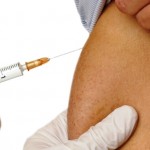 Protection against leading cause of acute hepatitis lasted more than 4 years, Chinese researchers report.
Protection against leading cause of acute hepatitis lasted more than 4 years, Chinese researchers report.
A vaccine against hepatitis E (HEV) provided protection against the virus for more than 4 years, researchers reported.
In a randomized clinical trial, volunteers getting the HEV vaccine (Hecolin) were significantly less likely to acquire the virus than those getting a control hepatitis B vaccine, according to Ning‑Shao Xia of Xiamen University in Xiamen, China, and colleagues.
Over 54 months of follow-up, more than 85% of those who received all three doses of the vaccine maintained antibodies to HEV, Xia and colleagues reported in the New England Journal of Medicine.
HEV is an important cause of acute hepatitis worldwide, the researchers noted, with two distinct epidemiological patterns — waterborne infection and transmission from animals to humans and among humans.
The waterborne infection, caused by HEV genotypes 1 and 2, primarily takes place in resource-limited areas, while the zoonotic and human-to-human transmission occurs in both developed and developing regions.
One analysis suggested the impact of HEV genotype 1, in regions where the virus is endemic, might be 3.3 million cases yearly, resulting in 70,000 deaths and 3,000 stillbirths, the investigators noted.
In most patients, symptomatic HEV leads to an acute hepatitis that is “indistinguishable from other forms of acute viral hepatitis, is usually self-limited, and does not become chronic,” the researchers wrote, except in people with severely compromised immune systems.
On the other hand, disease can be severe in pregnant women, elderly men, and people with pre-existing chronic liver disease, they noted.
The vaccine under study is based on HEV genotype 1 and was licensed in China in 2012, but information on its long-term efficacy wasn’t available. To fill the gap, the researchers studied participants in the original 19-month efficacy study for an additional 36 months.
Over the whole study, the researchers found 60 cases of hepatitis E, seven of them in the 53,602-strong vaccine group and 53 among the 53,602 control volunteers who got a hepatitis B vaccine.
Those numbers yielded incidence rates of 0.3 cases and 2.1 cases per 10,000 person-years, respectively, representing a vaccine efficacy of 86.8%, the investigators reported.
Over the trial and extended follow-up, 87% of participants who were seronegative at baseline and who received three doses of the vaccine maintained antibodies against HEV for at least 4.5 years.
Also, HEV antibodies developed in 9% in the control group, they reported.
The investigators reported that the rate of serious adverse events was similar between arms of the study, but none was thought to be related to the study drug.
The vaccine fills a need but it’s not clear how large that need is, commented Eyasu Teshale, MD, and John Ward, MD, both of the CDC in Atlanta.
While it’s clear that HEV causes death and illness on a large scale in some parts of the world, there is an “absence of precise data regarding the burden of hepatitis E disease and related deaths,” they noted in an accompanying editorial.
In particular, there is only limited information on infection during childhood, suggesting a need for prospective studies that will provide reliable estimate of HIV incidence and mortality among pregnant women, newborns, and children, they argued.
The knowledge gaps “extend to the U.S.,” where a lack of FDA-approved tests and case definitions make definitive diagnosis and reporting difficult, they wrote.
On the other hand, CDC testing has shown evidence of HEV genotype 3 transmission in the U.S., including among solid-organ transplant recipients, they noted.
The agency has also supported two national labs in sharing data from HEV testing, using both antibodies and RNA. In addition, Teshale and Ward argued, epidemiologic studies are needed to define populations that have a burden of HEV and might benefit from vaccination.
In the meantime, physicians should consider HEV as part of the differential diagnosis for hepatitis, they concluded.
Xia and colleagues cautioned that a majority of cases among study participants were caused by HEV genotype 4, while the vaccine is based on genotype 1. The efficacy of the vaccine against other HEV genotypes “remains to be explored,” they noted, but add that all HEV genotypes belong to the same serotype so that one vaccine can protect against any genotype.
They also noted that irregular follow-up assessments might have led to missing some HEV cases if participants did not seek medical care.
Source: MedPage Today

















